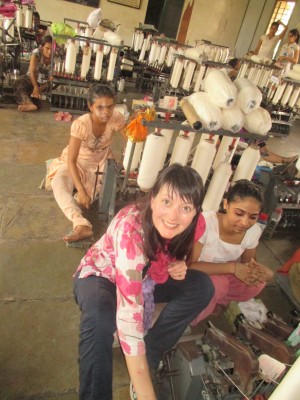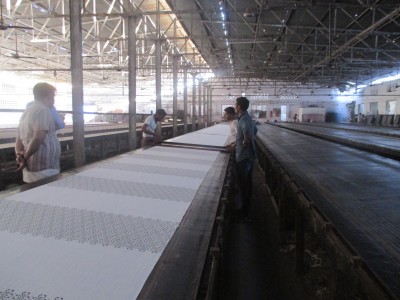Where Does It Come From? – A trip to India to Find Out!
I’ve just returned from the whirlwind of noise, colour, heat and spice that is India! The purpose of the trip was primarily to visit the people who make the clothing we sell and to experience first-hand their working conditions and lifestyles. The ethos of Where Does It Come From? (wheredoesitcomefrom.co.uk) is all about creating clothes that tell their stories – enabling customers to find out about the people who made their clothes and how they do it. We believe that having a deeper understanding will make you love and respect your clothes more. The world we live in now, with its transport and technology options, makes it easy for us to have connections with people wherever they are, so why not connect with the people who make all our ‘stuff’ for us? (Or do we simply find it easier if we don’t know?)
Visiting the Artisans
 We landed in Ahmedabad on Sunday morning and the fun started immediately! We were invited to the wedding of our designer Sanjay’s brother. It was a wonderful experience and such an honour to be there. I spent the majority of the time oohing and ahhing over the beautiful sari’s and lovely fabrics! We also bumped into one of the tailors, Rajubhai, who has already featured in one of our garment stories (for organic shirts) so it was lovely to meet him in person. We were being hosted by our suppliers Moral Fibre Fabrics, and staying in the home of their founder Shailini Sheth Amin. It is people who make change happen, through determination and working together. I now consider Shailini as an ally and friend so being invited to her home was a pleasure and privilege.
We landed in Ahmedabad on Sunday morning and the fun started immediately! We were invited to the wedding of our designer Sanjay’s brother. It was a wonderful experience and such an honour to be there. I spent the majority of the time oohing and ahhing over the beautiful sari’s and lovely fabrics! We also bumped into one of the tailors, Rajubhai, who has already featured in one of our garment stories (for organic shirts) so it was lovely to meet him in person. We were being hosted by our suppliers Moral Fibre Fabrics, and staying in the home of their founder Shailini Sheth Amin. It is people who make change happen, through determination and working together. I now consider Shailini as an ally and friend so being invited to her home was a pleasure and privilege.
 Monday and Tuesday were spent travelling through the Gujarat countryside (crazy driving!) visiting the co-operatives involved in making our clothes. The co-operatives we were visiting were in Gondal, around 4 hours drive from Ahmedabad where we were based. These co-operatives were set up using the principles set out by Mahatma Gandhi for social inclusion (particularly for women) and the welfare of rural people. They have a ‘whole family’ approach – covering not just employment but also offering services such as banki
Monday and Tuesday were spent travelling through the Gujarat countryside (crazy driving!) visiting the co-operatives involved in making our clothes. The co-operatives we were visiting were in Gondal, around 4 hours drive from Ahmedabad where we were based. These co-operatives were set up using the principles set out by Mahatma Gandhi for social inclusion (particularly for women) and the welfare of rural people. They have a ‘whole family’ approach – covering not just employment but also offering services such as banki ng. We set off very early and reached there midmorning. At the first location there were weavers and spinners working in large, cool studios, driving the machinery by hand or foot. The spinning charkhas are hand driven and can spin up to 12 spools of yarn at a time and the weaving looms are run by foot pedal. I was able to have a go at the spinning which was not too physically intensive – although I think I might develop better arm muscles if I did it for a long time. I also can’t vouch for the quality of my yarn! We were able to see many of the fabrics created at the co-operative – they even create denim fabric for Levis – which gave us lots of ideas for future designs. Handwoven fabric is naturally more breathable than machine fabrics due to the wider weave and 100% cotton makes the fabric soft and comfortable. The fabric produced this way is known as ‘Khadi’ and was much promoted by Gandhi during the movement for Indian independence. It had fallen out of fashion but is making a big come-back in India and being adopted by designers due to its positive qualities.
ng. We set off very early and reached there midmorning. At the first location there were weavers and spinners working in large, cool studios, driving the machinery by hand or foot. The spinning charkhas are hand driven and can spin up to 12 spools of yarn at a time and the weaving looms are run by foot pedal. I was able to have a go at the spinning which was not too physically intensive – although I think I might develop better arm muscles if I did it for a long time. I also can’t vouch for the quality of my yarn! We were able to see many of the fabrics created at the co-operative – they even create denim fabric for Levis – which gave us lots of ideas for future designs. Handwoven fabric is naturally more breathable than machine fabrics due to the wider weave and 100% cotton makes the fabric soft and comfortable. The fabric produced this way is known as ‘Khadi’ and was much promoted by Gandhi during the movement for Indian independence. It had fallen out of fashion but is making a big come-back in India and being adopted by designers due to its positive qualities.
A Green Approach
 Solar power is increasing as an alternative method of powering the looms and
Solar power is increasing as an alternative method of powering the looms and charkhas. A ‘Green Centre’ has been set up using only solar power which harnesses the almost constant sunshine (up to 45 degrees when we were there!). The older ladies who have worked for the co-operative for a long time get the opportunity to work there as a promotion – it is less effort and it produces more yarn (which is a bonus as they are paid based on the amount of yarn they create)
charkhas. A ‘Green Centre’ has been set up using only solar power which harnesses the almost constant sunshine (up to 45 degrees when we were there!). The older ladies who have worked for the co-operative for a long time get the opportunity to work there as a promotion – it is less effort and it produces more yarn (which is a bonus as they are paid based on the amount of yarn they create)
Printing the Designs
 During the rest of the week we were back in the city of Ahmedabad and we were able to visit the fabric printing unit (used for our scarves and shirts) and a tailoring unit (which we used for our denim children’s clothes). The printing process is fascinating – the fabric is stretched out over long work benches covered in wax and then flattened out so there are no wrinkles. The designs are added either by printing with carved blocks (such as the prints on ours scarves) or using screens with holes in that create a more uniform pattern.
During the rest of the week we were back in the city of Ahmedabad and we were able to visit the fabric printing unit (used for our scarves and shirts) and a tailoring unit (which we used for our denim children’s clothes). The printing process is fascinating – the fabric is stretched out over long work benches covered in wax and then flattened out so there are no wrinkles. The designs are added either by printing with carved blocks (such as the prints on ours scarves) or using screens with holes in that create a more uniform pattern.
Fashion Revolution
 Last week was also Fashion Revolution Week (www.fashionrevolution.org), the third anniversary of the Rana Plaza garment factory collapse in Bangladesh. This anniversary is a big driver for us as customers to ask our brands who makes our clothes, in order to draw attention to the appalling working conditions endured by many well-hidden garment workers. To support this cause we publicised images of our garment workers so that people can see the faces of those making what they wear. We also gave a presentation to young students at an Ahmedabad Design college to encourage them to move forward in their careers with sustainability in mind. There was quite a lot of press present at our presentation – a great way to publicise the Fashion Revolution message – and it felt very strange to see myself in the newspaper next morning without being able to understand a word of what was written! (one was in English – phew!).
Last week was also Fashion Revolution Week (www.fashionrevolution.org), the third anniversary of the Rana Plaza garment factory collapse in Bangladesh. This anniversary is a big driver for us as customers to ask our brands who makes our clothes, in order to draw attention to the appalling working conditions endured by many well-hidden garment workers. To support this cause we publicised images of our garment workers so that people can see the faces of those making what they wear. We also gave a presentation to young students at an Ahmedabad Design college to encourage them to move forward in their careers with sustainability in mind. There was quite a lot of press present at our presentation – a great way to publicise the Fashion Revolution message – and it felt very strange to see myself in the newspaper next morning without being able to understand a word of what was written! (one was in English – phew!).
In between these excitements we spent time planning future designs and even going out enjoying ourselves – the food was amazing – and we also managed some shopping! We travelled back with heads full of experiences and ideas and suitcases full of fabric……
Welcome to
Ethical Fashion SOURCE Network
© 2025 Created by Ethical Fashion Forum.
Powered by
![]()
You need to be a member of Ethical Fashion SOURCE Network to add comments!
Join Ethical Fashion SOURCE Network